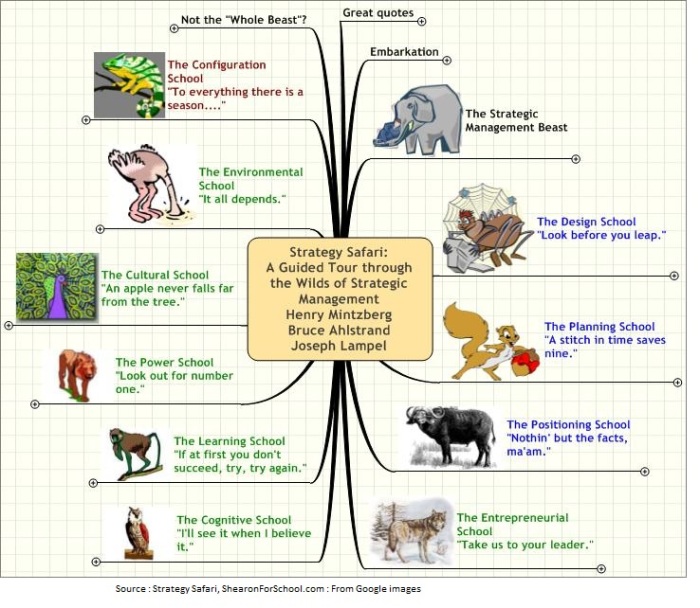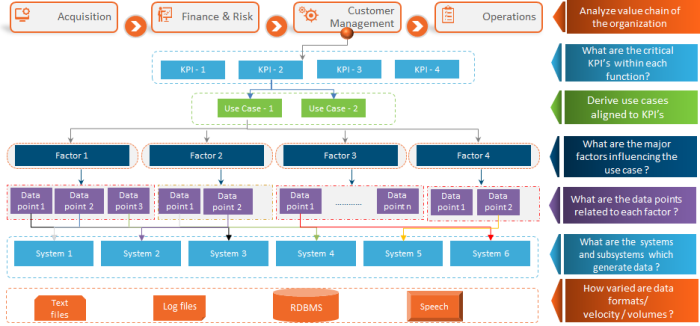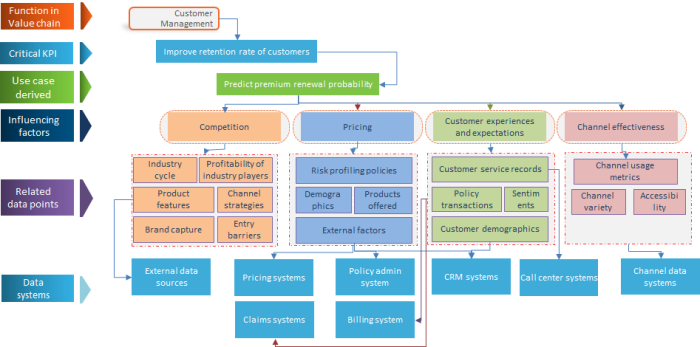By Thomas Joseph, Aspire Systems

Back from the days when I was a management student a classic work on strategy,which inspired me was “Strategy Safari” by Henry Mintzberg, Bruce Ahlstrand, and Joseph Lampel. Strategic Safari, describes different perspectives on strategy as summarised in the attached matrix.
 Figure 1 : Facets of Strategy Formulation
Figure 1 : Facets of Strategy Formulation
These multiple facets of strategy did play a significant part in defining my perspectives on strategy.There is no doubt that works of other greats in the field like Peter Drucker and Michael Porter did shape my thinking process and my perspectives on strategic management. However what made this book on top of my favourite list is the different angles through which the field of strategic management was looked at by the authors. The title of this post is derived by drawing inspiration from Mintzberg’s seminal work. In this post, I am attempting to take you on a safari through the data science strategy formulation process.
Data science strategy formulation : The big question
When formulating a data science strategy, a pertinent question one can ask is this. With tremendous strides data science is making in influencing business outcomes, should data science strategy lead organisation strategy or like any other functional strategy, should it be aligned to Organisational strategies ? Well, in my opinion, like any other functional strategy, data science strategy should also be aligned to organisational strategy. Data science domain would have no meaning if it is not used to support the organisation in meeting its overall objectives. And for this very reason I strongly believe that data science strategy has to be derived out of organisation strategy. So the next question is how do we define a data science strategy which is aligned to organisation strategy ? To answer that question let us decipher the strategic alignment framework.
Data science strategy safari : Alignment is the game
Strategic alignment is the process by which an organisation’s competencies,resources and actions are aligned to the planned organisational objectives. Data science has become a very critical competency an organisation have to build, to have an edge in this digitally connected era. However it is equally important that the output from a data science engagement i.e predictions,recommendations, inferential studies et al fits well into the overall scheme of strategic objectives an organisation wishes to pursue. This can be achieved by traversing the processes of the alignment framework. Figure 2 is the depiction of data science strategic alignment framework.
 Figure 2 : Data Science Strategic Alignment Framework
Figure 2 : Data Science Strategic Alignment Framework
The strategic alignment framework can be summarised into the following steps
Analyse the critical functions within the business value chain. Within each function, identify critical performance indicators. From each of the performance indicators derive predictive or inferential use cases which will help in realisation of those performance indicators. Create a web of such use cases which are aligned to each of those performance indicators. For each of the use case, identify business factors which influence that particular use case. For each of the factor identify related data points Identify the systems and subsystems which generate these data points and figure out ways to connect them to implement the use case.
These steps can be demarcated based on its value as “Strategic alignment” steps and “Operational alignment” steps. The first four belong to the first category and the remaining two to the latter.
Let us see the manifestation of the strategic alignment framework for the case of an insurance company. Let us take the case of a single function within the value chain i.e ‘Customer Management’.
 Figure 3 : Alignment process for an Insurance company
Figure 3 : Alignment process for an Insurance company
The trail for analysis for the customer management function is as depicted in figure 3 above. To ensure that data science strategy is aligned to organisational goals, the first step of the process is to identify Key Performance Indicators ( KPI’s ) for each function within the value chain. For the function ‘customer management’ which we are analysing, one critical KPI which has substantial impact on the top line and bottom line is “Improving customer retention rate”.
Having identified a critical performance indicator, alignment to it would entail deriving data science use cases which will help in achievement of this performance indicator . For customer management function a use case which will help in improving customer retention rate would be to predict probability of premium renewal. The output from this use case can be used for targeted campaigns towards customers who have low probability of renewing premiums, there by enabling achievement of the KPI. In addition to use cases which are directly related to the KPI we should also derive related use cases which will enable the process of achieving that KPI. For example having known which customer to be targeted, it would also be valuable to know specifics of how to target them,like predicting right time and channel to reach out to target customers or predicting right price point for giving them specific offers.
In a similar fashion, we have to look across all the functions,critical metrics within each function and derive all primary and related predictive use cases. These use cases can be formed into an interconnected web called Strategic Alignment Map ( SAM). Figure 4 below is a representative SAM depicting the business value chain,its critical functions, interconnected web of use cases and its corresponding category ( Natural Language Processing, Inferential , Machine Learning/Deep Learning, Other AI etc). A comprehensive SAM would form the blue print for aligning data science projects to organisational strategy and also in indicating inter dependencies between different use cases / models. In addition, it will also be an aid to get a view on various data science competencies which are required to add value to an organisation.
 Figure 4 : Strategic Alignment Map
Figure 4 : Strategic Alignment Map
Now that we have seen the process of creating the SAM, let us dive deeper and decipher the operational aspects of data science strategy.
Once we have an interconnected web of use cases critical for the organisation, the next task would be in getting data acquisition and integration strategies aligned to the overall strategy. To align data acquisition strategies to overall strategy we first have to know what kind of data points are required for implementing the use cases depicted in the SAM and also the characteristics of the data points like formats, velocity, frequency, data systems which generate them etc. A good approach to derive those details is to look at each use case, identify business factors influencing each of them and then working our way downwards.
For our specific use case i.e predicting renewal rate, some factors which have a bearing on the renewal rate are
(a) competition (b) pricing (c) customer experience & expectations & (d) channel effectiveness etc
A comprehensive list of factors like the above have to be identified through close discussions with business/domain teams. Having identified various factors affecting each use case the next task is to identify data points related to each factor. Some of the major data points related to factors influencing renewal rate is depicted in figure 5 below.
 Figure 5 : Data points related to factors
Figure 5 : Data points related to factors
The requirement for data points related to each factor governs data sourcing and integration strategies. From the various data points depicted above we can see that data requirements can be from within the organisation and also from external sources. For example, data points related to competition in all probability will have to be acquired from external sources. Other data points predominantly can be acquired from various systems within the organisation.
In addition, the factor analysis will also help in determining the data types related to each use case. Some of the data types related to the identified data points are as follows
Traditional RDBMS data (eg. demographics, customer records, policy transactions etc.) Text data ( customer reviews) Voice ( Call centre data) Log files( channel usage metrics,channel cookies etc.)
To have a comprehensive view of data requirements one will have to look at each factor through different facets. Various facets through which one have to look at each factor is as listed below
What are the data points ? How varied are the data types ? What are the sources of data ? Whether external or internal ? What frequency are these generated and captured ? How do we connect them together for implementing the use cases ?
These comprehensive views derived on the data requirements will help in aligning different components of data engineering strategies like data acquisition, data integration, data pre-processing and cleansing, data storage etc to overall organisational strategy.
Wrapping Up
Having seen the data science strategic alignment framework in action one can not help but wonder if we can draw parallels from the framework to some of the perspectives of Mintzberg’s “Strategy Safari”. The process steps encapsulated within this framework have elements of the Learning, Cognitive and Planning Schools of strategy formulation. However at the end of the day this framework, like any other framework, is aimed at structuring one’s though process towards achievement of certain objectives. The objective it aims to accomplish is to ensure that your data science efforts are aligned to overall Organisational goals and strategies.
Bio: Thomas Joseph is Senior Data Scientist at Aspire Systems, working on growing the Data Science footprint and enabling superior delivery.
Original. Reposted with permission.
Related: